[Tested] Specialized S-Works Enduro 29
For quite some time with the Enduro model, Specialized stuck with a rather consistent frame layout. It had a Horst link rear end driving a linkage that wrapped around the seat tube and compressed the rear shock where it butted up against their “X-wing” front end. Those days are over! In putting that design to rest, the new Enduro adopts the same layout as the new Demo, which Loic Bruni has been piloting to great success this year on the World Cup DH circuit. In addition to the suspension revamp, the bike also received a complete and total facelift on many other fronts as well. It sees updated geometry, says farewell to 27.5″ wheels, and in addition to increased travel it also sees more progressive kinematics – something I’ve been asking for on the bike for years now. Hallelujah!
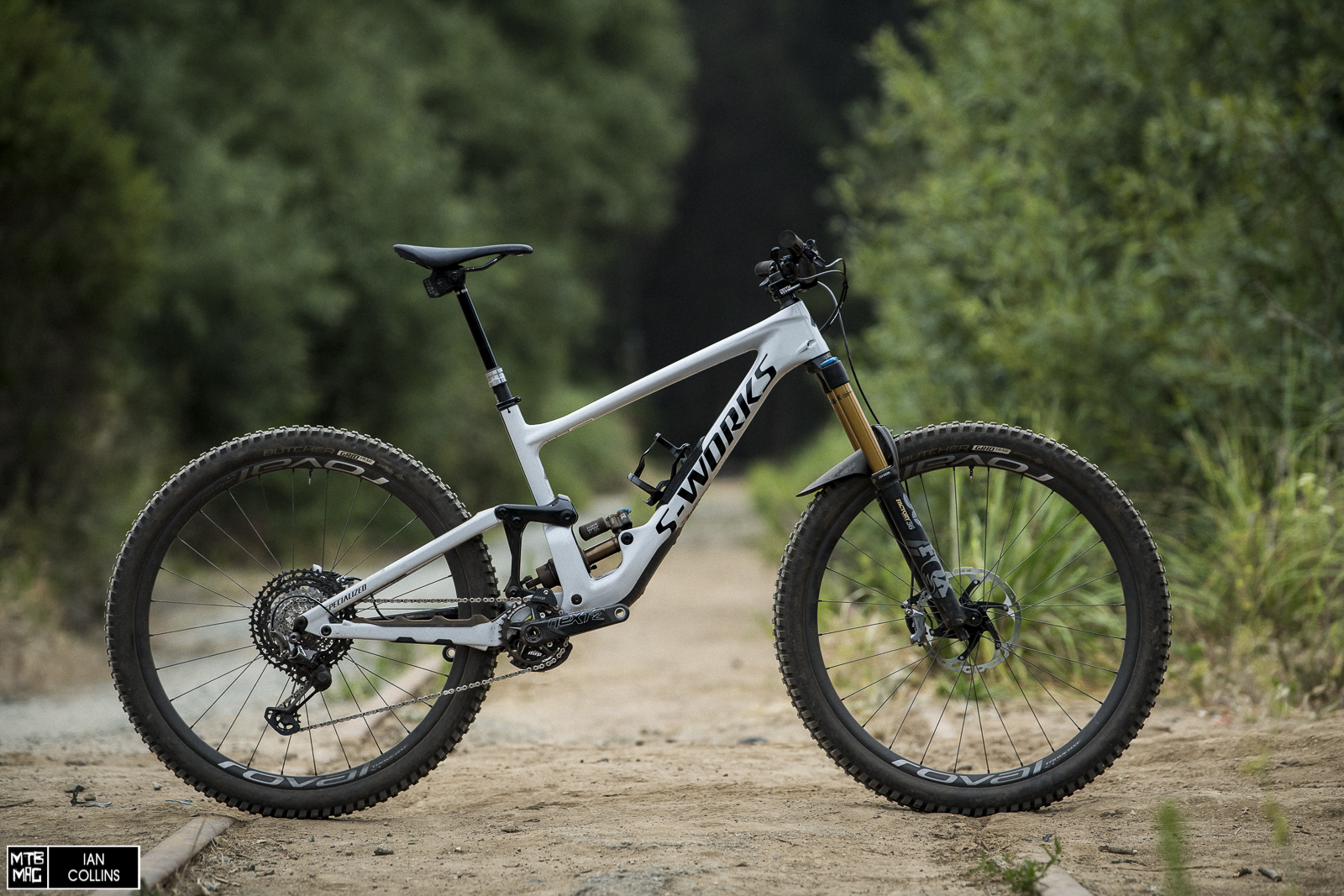
I got a chance to ride the flagship S-Works version of the new bike in the “S4” sizing, which is roughly equivalent to a Large. It’s a hell of a lot of bike, but it managed the climbs surprisingly well over quite a few big days during the last few weeks. Note: typically if we only get few rides on a bike we label an article “First Look”, but if we’ve quite a bit of time we’ll label it a “Test”. This review was done on the shorter end of what we’d consider a test, but the bike saw a great deal of ride time in a short timeframe. Anyhow – here’s the low down on the completely revamped smasher bike…
Details
- 29″ Wheels only
- Carbon fiber only
- 170mm front and rear travel
- Four sizes: S2, S3, S4(tested), S5
- 40% increase in anti-squat
- 12% increase in frame stiffness
- Progressive kinematics & a more rearward axle path
- Metric, trunnion shock spacing (205mm X 60mm)
- Boost front and rear hub spacing
- SWAT downtube storage
- Sleeved, internal cable/hose routing
- Short offset fork
- Flip chip in lower shock eyelet
- No custom shock hardware
- 30lbs 15oz no pedals, tubeless, with full chainguide
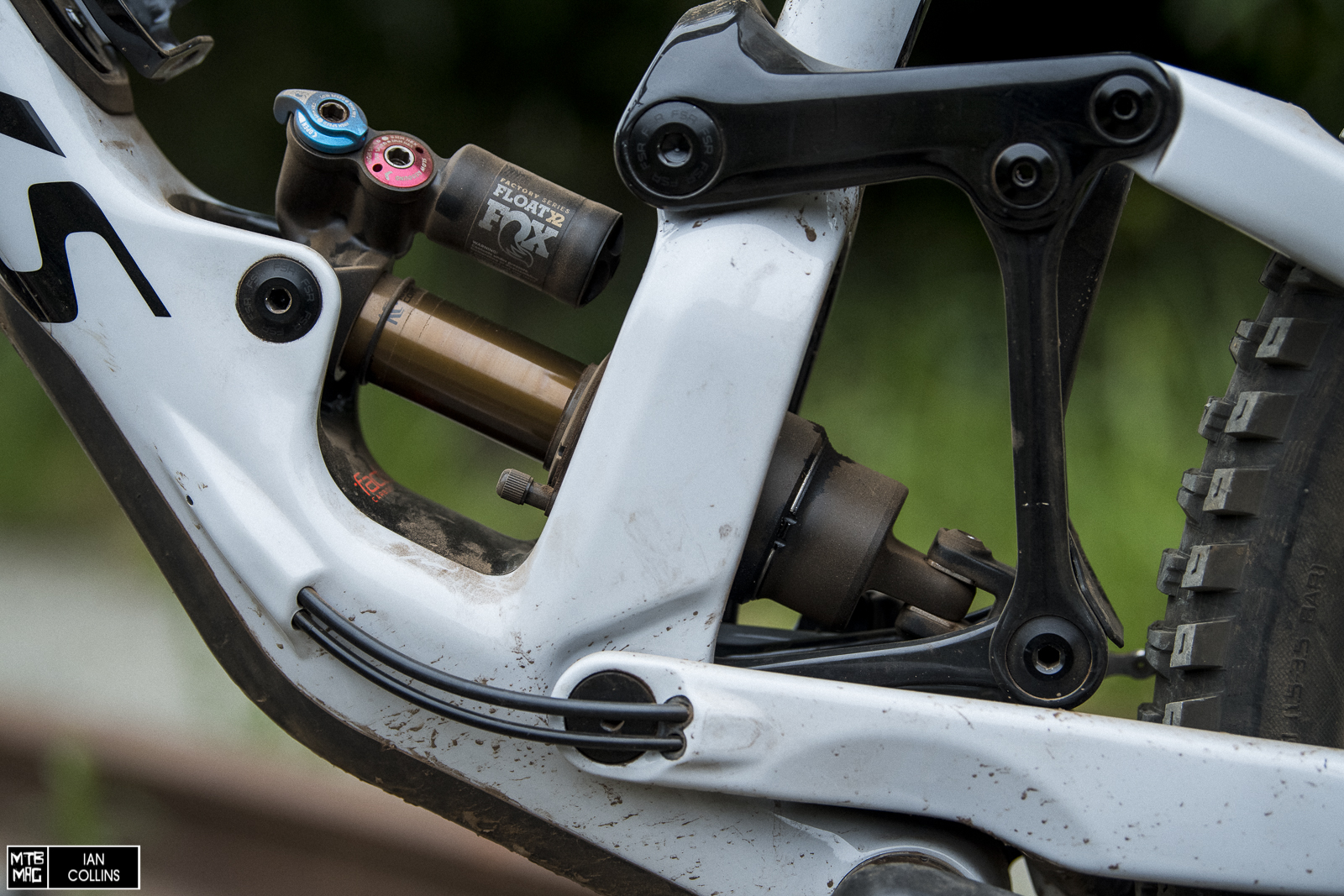
The industrial design of the new bike is all about clean lines as you can see from the cable/hose’s transition from front to rear end, which is sleeved by the way. The trunnion mount shock rides on cartridge bearings housed in the frame at the upper mount. Specialized opted for the FOX Float X2 with 4-way adjustability and a lockout lever. The new linkage is fully carbon on the S-Works model and features a plastic guard to protect the shock from debris flinging off the rear wheel.

Some details on the frame, clockwise from left: The downtube guard is quite massive, and removable. The upper portion of the linkage pulls on the lower portion, which drives the shock. This single upper part wraps around the seat mass with a bridge for the sake of rigidity. Lastly, even with a 2.6″ tire, the clearance was quite good.

Clockwise from left: the SWAT CC is one of our all time favorite accessories. It neatly stashes a multi-tool in your headtube while doubling as a headlock and a chain tool, as well as storing a spare chain link. The SWAT downtube is one of the best inventions mountain bikes have ever seen. You can store a great deal of things in the downtube, accessible via a door under the bottle cage. Lastly, a closeup of the lower shock eyelet which has “flip chip” style between high/low adjustability without the use of any proprietary shock hardware.
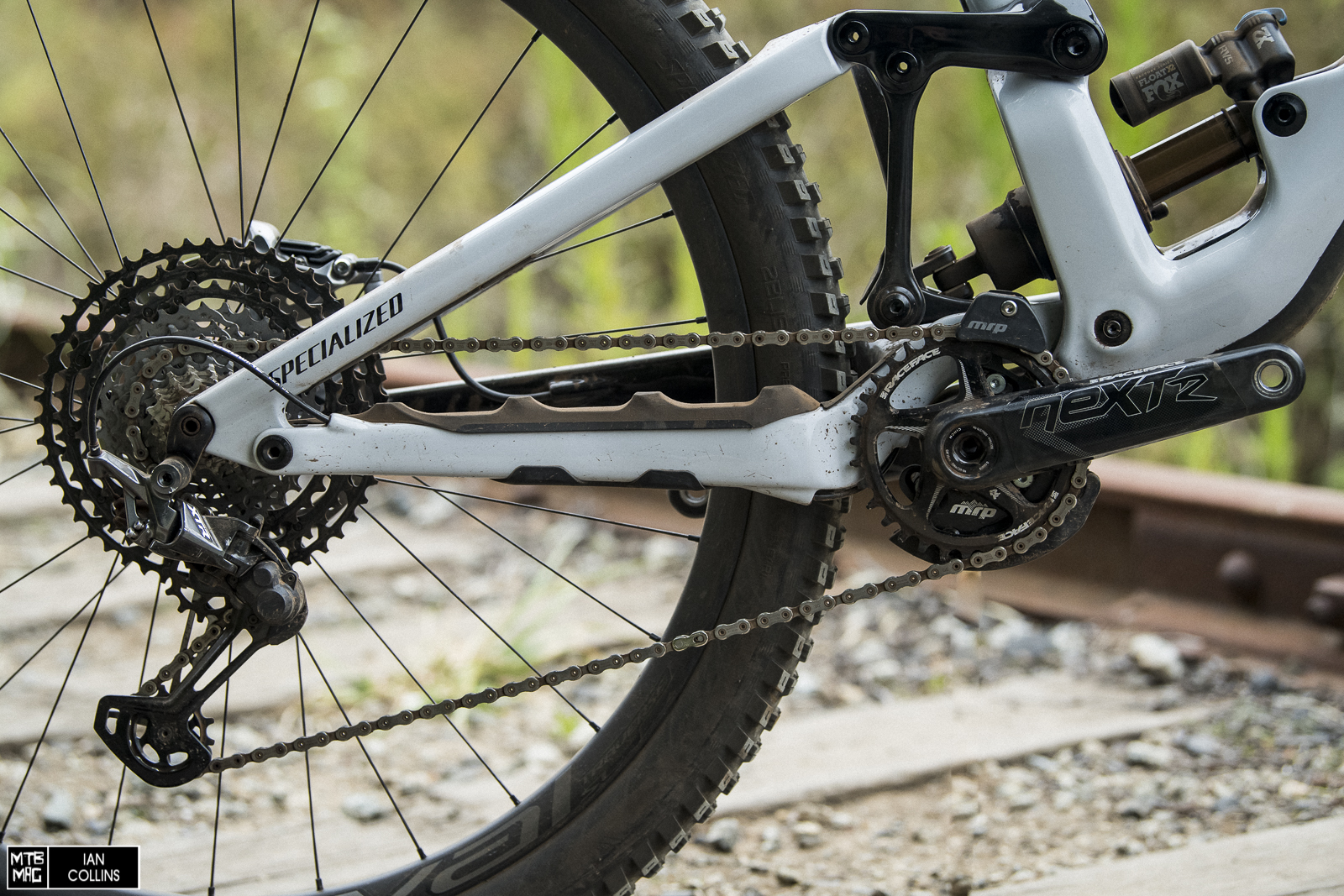
The S-Works which we tested sees the new Shimano XTR 12-speed drivetrain. It has a 10-51 tooth rear cassette for a massive range. This is paired with Race Face’s super light but strong Next-R carbon crankset and an MRP chainguide. Also visible is the rubber chainstay protection with 4 raised nubs which help silence things – an idea Specialized pioneered.
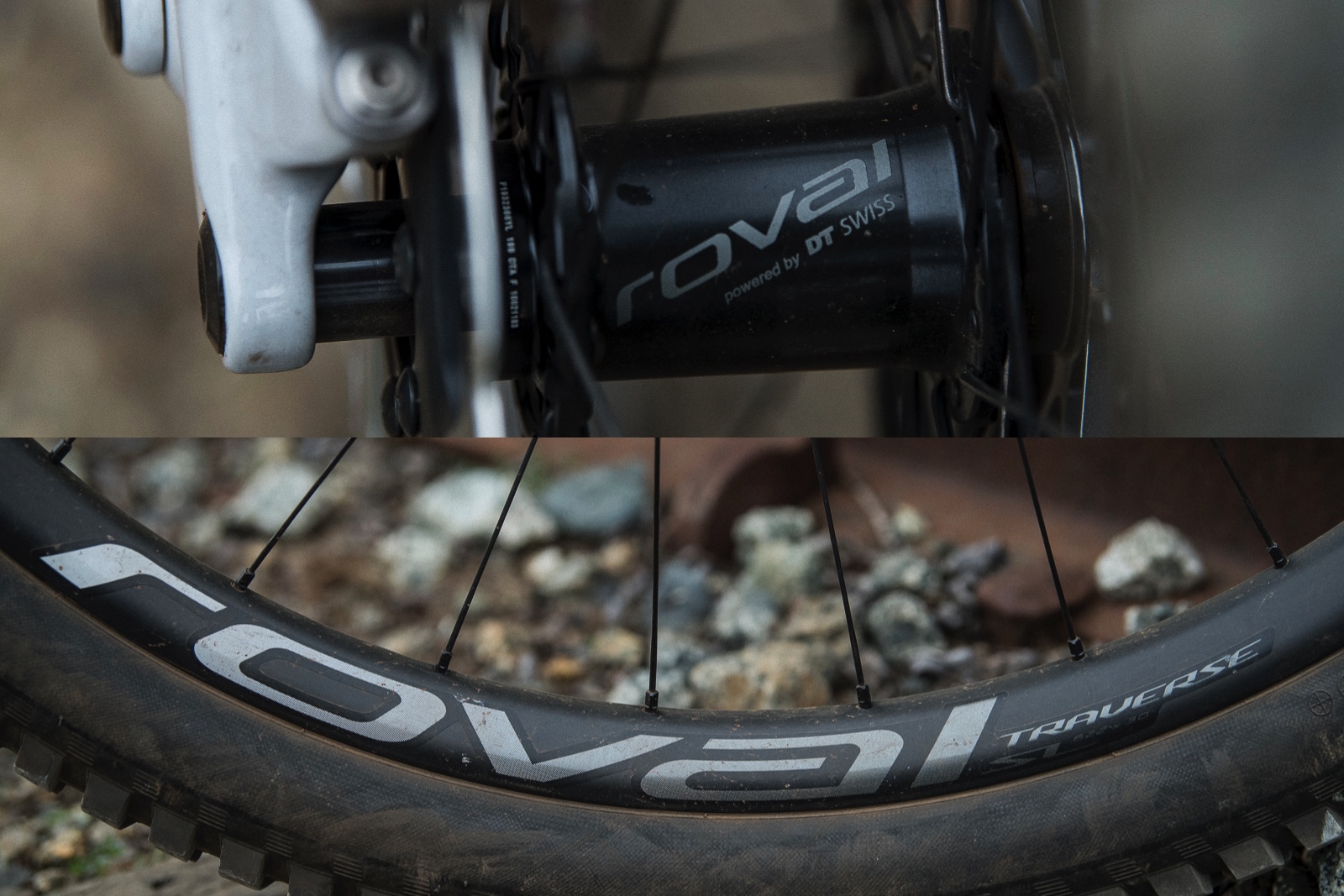
Unsurprisingly, the bike comes fitted with Roval Traverse SL wheels. Being under the Specialized umbrella, Roval takes advantage of their expertise on carbon fiber with tough, dependable rims that boast a very nice ride quality. They lean on DT-Swiss for the hub parts and engagement mechanism, which have also proven their mettle.
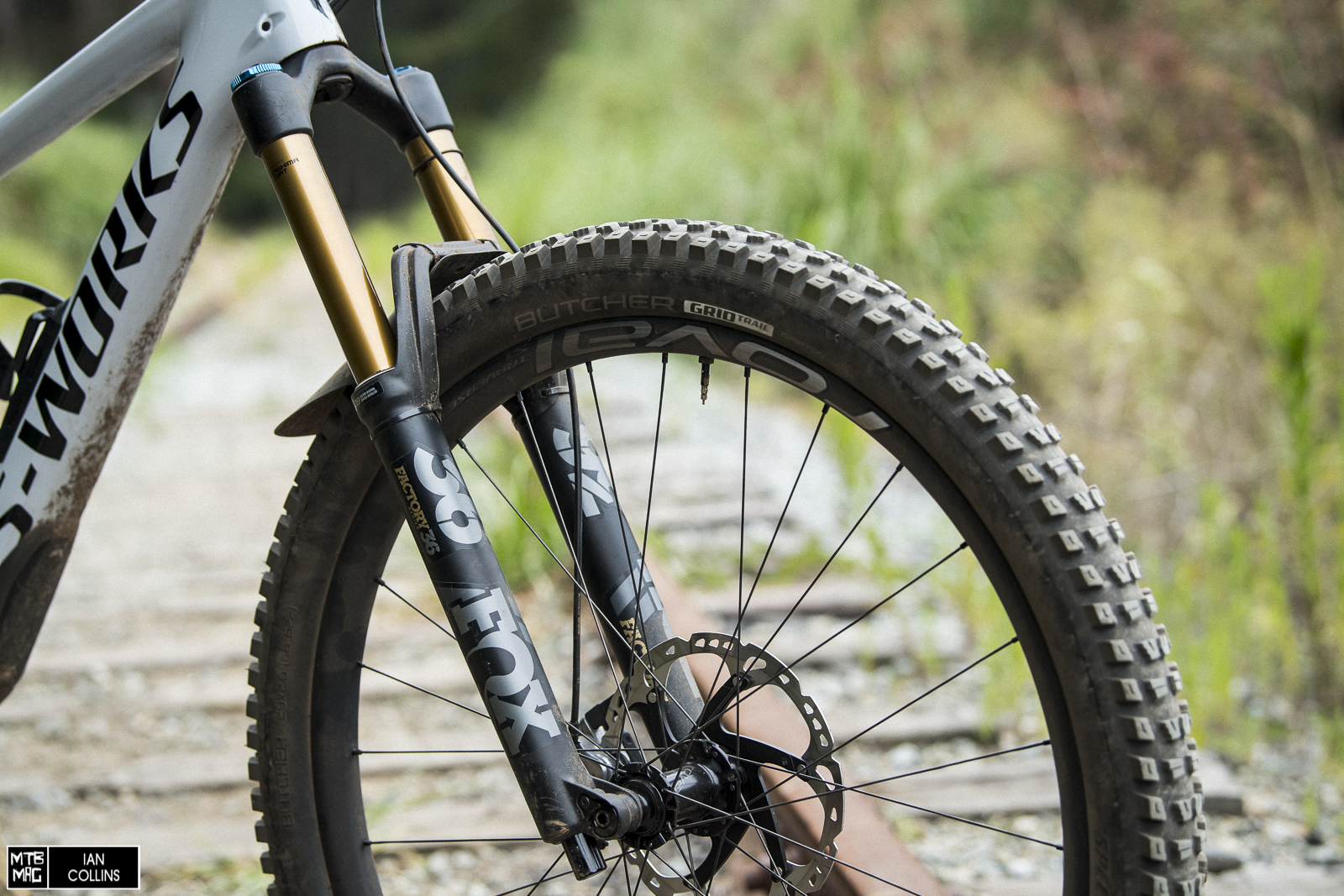
Up front is a massive 170mm travel Fox 36 Factory with the truly excellent Grip-2 damper. Like the rear shock, it features 4-way adjustability: high/low speed compression and rebound. The Enduro features in house “Butcher” tires in a 2.6″ width with the “Grid Trail” casings – which are likely a bit on the light duty side of things given the bike’s penchant for disregard on trail.
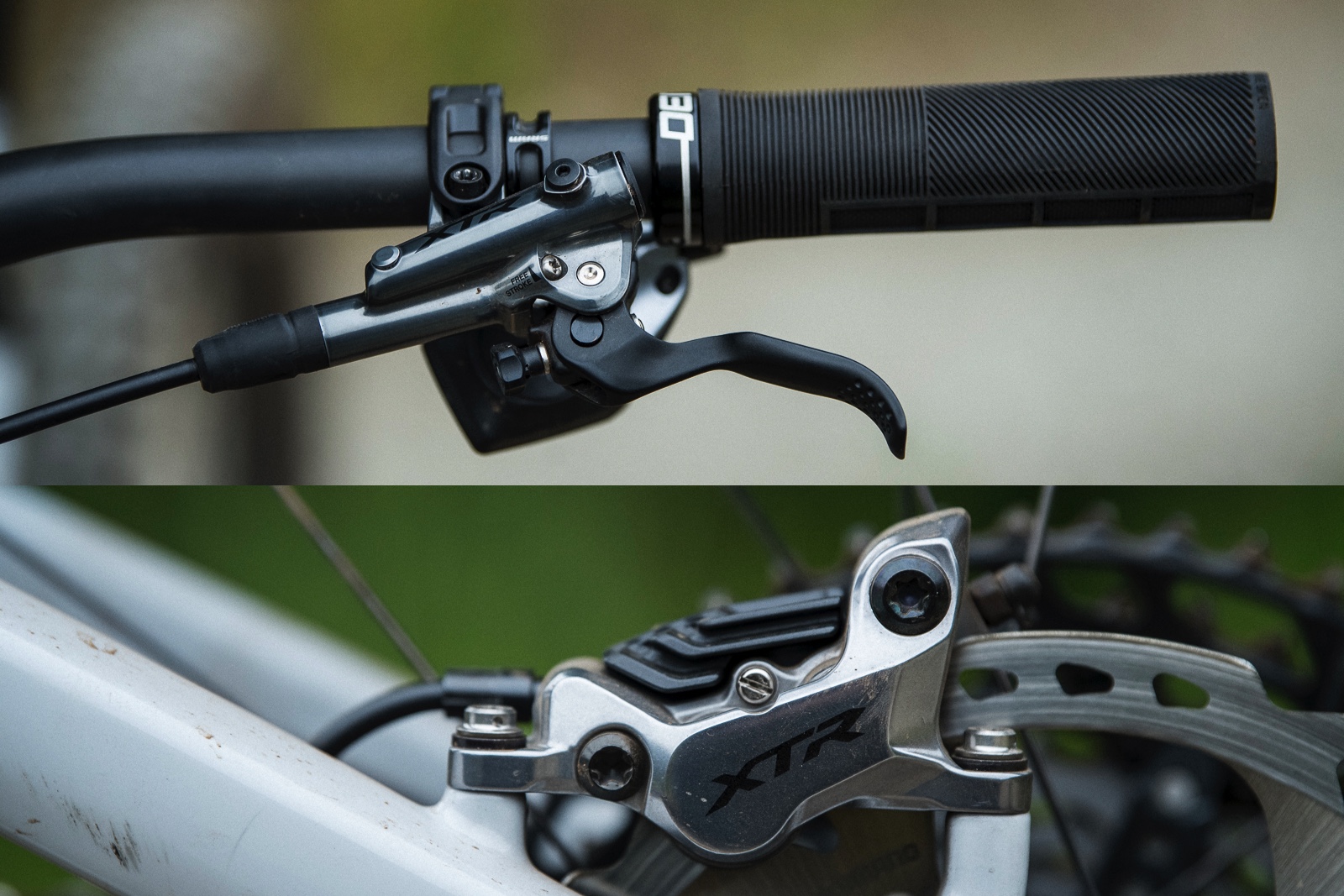
The Enduro S-Works comes with 4-piston Shimano XTR brakes with a 200mm front / 180mm rear rotor combo, which is quite fitting given the bike’s purported intentions. Deity’s Knuckleduster grips are a nice addition and an excellent replacement for the less than stellar in-house grips from Specialized.

With a 170mm travel RockShox Reverb AXS seatpost spec’d, that leaves one sad, lonely cable port at the head tube and a tidier looking front end. A very worthy choice for the saddle, the Specialized Henge features a nice contour, just the right amount of padding and a slightly wide rear combined with a fairly short length. Perfect for a gravity bike that has to climb.

Two things here: Specialized does away with the “S-Works” labelled handlebar, and moves that detail over to Roval world. We’ve enjoyed their in house bars in past tests with comfortable angles and nice carbon layups. The new offering is a full 800mm wide, but now sees a 35mm bulge mated with a Deity Copperhead stem.
Geometry
This update brings a complete transformation to the Enduro. Specialized jumps on board the “Speed Balanced Geometry” trend that was originally fashioned by Transition a couple of years ago. This boils down to: Longer top tubes and a slacker head angles paired with short offset forks to improve the confidence and handling on the descents, while steep seat angles help improve body positioning for the climbs.
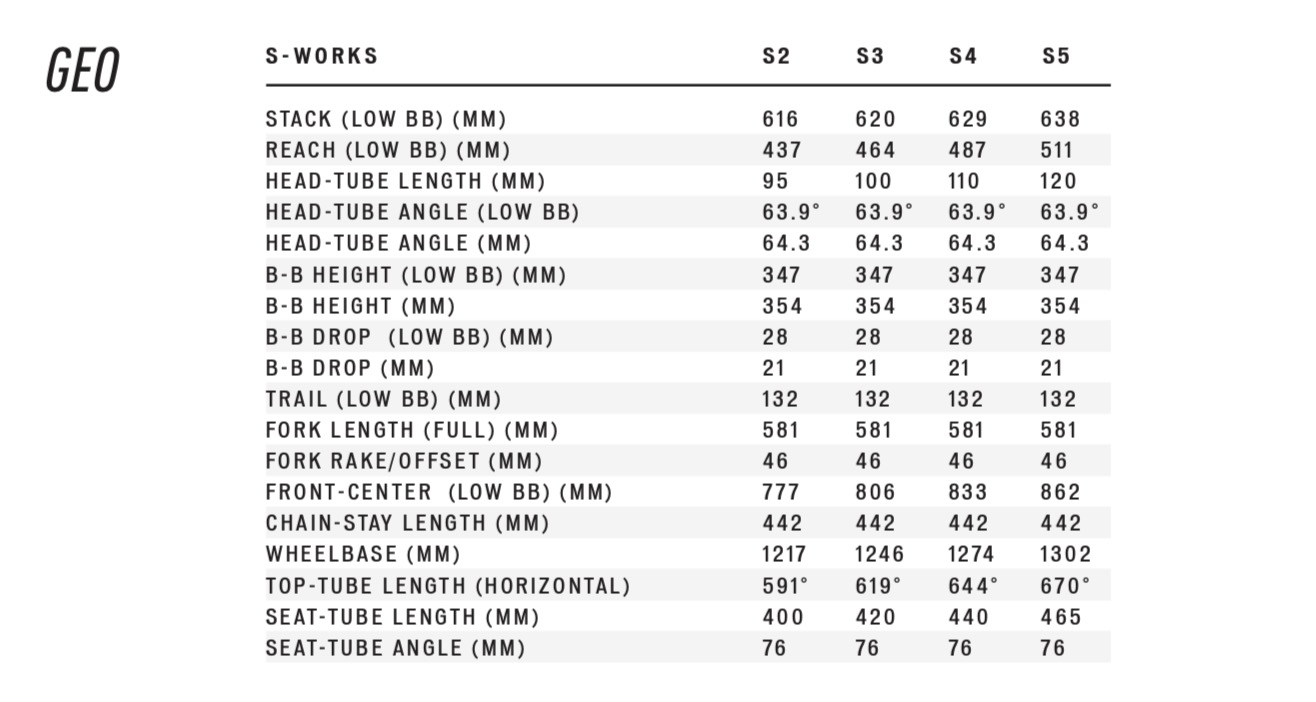
On the Trail
Most good rides start with climbing, right? I said good, not epic…We all know epic rides start with heli drops. Anyhow, from a body positioning standpoint, with the seat extended the Enduro puts you in an upright position that’s easy to weight the front end, ready for all day affairs. The ultra slack 64.3º head angle, and that’s in the high/”steep” position, had a slight knack for wandering at low speeds, but to a certain degree that’s to be expected for a bike of this stature. From a pedaling efficiency standpoint, this bike is freakishly good – I can’t overstate it enough. I never once touched the lockout lever – the rear end is simply unfazed by pedal input. This of course is extremely impressive when you consider that it boasts 170mm travel.
Once you point the bike in the other direction things begin to get exciting. To start, this is a completely different animal than the last Enduro – there is no longer anything familial between the old and new versions. Starting with geometry, the bike is finally, truly on trend and fits properly while putting you in the right place. The long reach allows you to hover front to back as the trail requires without any fear of bungled up too far over the front or off the back. Stretched reach, an ultra slack head angle and longer 442mm chainstays make the bike more of an EWS inspired race machine, boasting confidence and stability on all terrain, whether it’s blind, steep, fast, haggard or all of the above. This does come somewhat at the expense of the fun, slappy, easy-to-manual nature that the last Enduro enjoyed, although under the right pilot loads of fun will still be had – it will just require more input, skill and energy. Despite only having just a few millimeters more travel, this is a LOT more bike. Make no bones about it, this Enduro borders on a downhill bike levels of capability.

Regarding suspension, Specialized has made serious improvements all around – in my opinion anyway. In the past, I’ve criticized them for the linearity of their rear suspension designs and the high leverage ratio, which are less than ideal, especially when combined The former has been improved massively – the progression sits at a high figure of 38.6%. The latter improved nominally from a 2.97:1 ratio down to 2.83:1, which is still relatively high, but the added progression takes the load off the shock by making the linkage responsible for increasing ramp. There was enough progression that I actually ended up running the Float X2 with zero volume reducers. The bike ships with one reducer, and after feeling it rode a touch on the rough side, I pulled that spacer out, hunting for and finding a touch more traction. This is good because it provides riders with usable range in tuning how linear or progressive the bike is, depending on personal preference. It also indicates the bike would likely work very well with a coil sprung rear shock. My final settings strayed a bit from the base recommended tune. At 185 lbs I arrived at 222PSI for 18mm (30%) sag, 12 clicks from closed on low speed compression and rebound, and 11 and 15 from closed on high speed compression and rebound respectively.
The other key chapter in the suspension story is the Enduro’s improved axle path, due to its completely updated pivot layout. Specialized moved the main pivot further forward to attain a more rearward axle path. This helps the bike carry speed over rough sections, since the rear wheel moves back and away from impacts as it goes up through its travel. In addition to more momentum, it sees improved stability when it needs it most. On trail, this was very apparent right away – compared to Enduros past, this new machine manages the roughest of sections with much improved prowess. This meant better behavior on things like successive mid-sized chunder and braking bumps, while the progressive nature of the suspension helped with small bump sensitivity and big hit bottoming resistance.

As far as the spec goes – I found most everything to be excellent, as it should be on a flagship bike at this price point. And thus, that is largely why I’ve dedicated the majority of the dialogue on the new frame’s behavior. After all, that is where the real interesting story lies. Touching briefly on some observations on the components, I think the product managers have done an excellent job curating a good build, even down to the grips. Starting with the fork, the most recent Fox 36 and its Grip-2 cartridge needs no introduction. It has 4-way damping adjustability, and its air spring curve felt just right out of the box, so I didn’t need to mess with tuning via volume reducers. An ultra stiff chassis paves the way with precise steering no no unwanted deflection, while buttery smooth action eats everything up.
The Shimano XTR brakes were freakishly strong – so much so that for the first time, I was almost wishing for a bit more modulation on some of the steeper bits. No complaints though as the bike is designed for the rowdiest of riding and that power came in handy elsewhere. As for the new XTR drivetrain, it provides good shifting albeit less crisp than Eagle, but with slightly better performance when mashing/shifting under load. The range on both groups is all you’ll ever need. It’s a Mac or PC argument best left to personal preference, but I nod toward SRAM. The Race Face cranks that the drivetrain is paired to are quite stiff – time will tell on strength, but in the short run, they tick the boxes.

I’m a big fan of Roval wheels for their excellent on trail feel and ideal strength to weight ratio. The flagship SL version of the carbon fiber hoops spec’d here are no exception, offering fast hub engagement, great acceleration, chatter damping properties and a very lively nature. If I had to pick one thing that I’d swap out, it’d be the tires. I think the Butcher’s tread pattern itself is great, but I’m less fond of the rather thin casing. I’m even less enthused by the compound, which has a fairly fast rebound characteristic, making it a bit nervous on hardpack. I liked having the increased volume of the 2.6″ up front, but would opt for a 2.3 or 2.4″ tire out back, personally.
The cockpit is a place that many brands miss the mark, but in the case of this bike, it’s absolutely phenomenal. I loved the rise, width and sweep combo of the new 35mm Roval handlebar, and the Deity stem’s low stack height provided lots of room for adjusting bar height – their grips were also quite comfortable and grabby. I personally mesh well with the Specialized saddles and the Henge was no exception. Last and certainly not least, the wireless, electronic RockShox Reverb AXS is an incredible piece of kit. It cleans up your cockpit, makes maintenance easier and its 170mm of travel matches the front and rear suspension, offering plenty of drop for long legged riders. The SWAT downtube is a standout frame feature that you’re likely well familiar with by now – it makes life way easier, just like the sneaky multi tool in the head tube.
Overall
After a few years of making small improvements and refining an increasingly tired layout, I’m happy to see Specialized start from scratch with the new Enduro. The geometry is on the bleeding edge, but manages to be extremely well balanced. The suspension is a massive improvement over past models, boasting just the right progression and knack for carrying speed. If you’re looking for a sprightly little play toy, this isn’t the bike…If your trails are tame, you may as well look elsewhere. This is a bike meant for pushing the limits of what you can do with a single crown bike. Also, something that shouldn’t be overlooked is what an incredible job it does at getting you back up the hill, particularly given its stature. Aside from the fact that I’d likely opt for different tires, there is one other downside which is unfortunately immutable – it has a fairly high standover. It’s the kind of thing that you usually don’t notice, but can be a peeve for some people and therefore is worthy of mention. Aside from those minor quips, I think this bike will treat most people very, very well. For those looking to get the absolute most out of a bike that will get you back up the hill without a chairlift or a shuttle, it would be foolish not to consider the new Enduro.
Pricing
- Enduro Comp 29: $4,510
- Enduro Elite 29: $5,310
- Enduro Expert 29: $6,550
- S-Works Enduro 29: $9,750
- S-Works Enduro 29 frame-only: $3,310
The post [Tested] Specialized S-Works Enduro 29 appeared first on MTB-MAG.COM.
